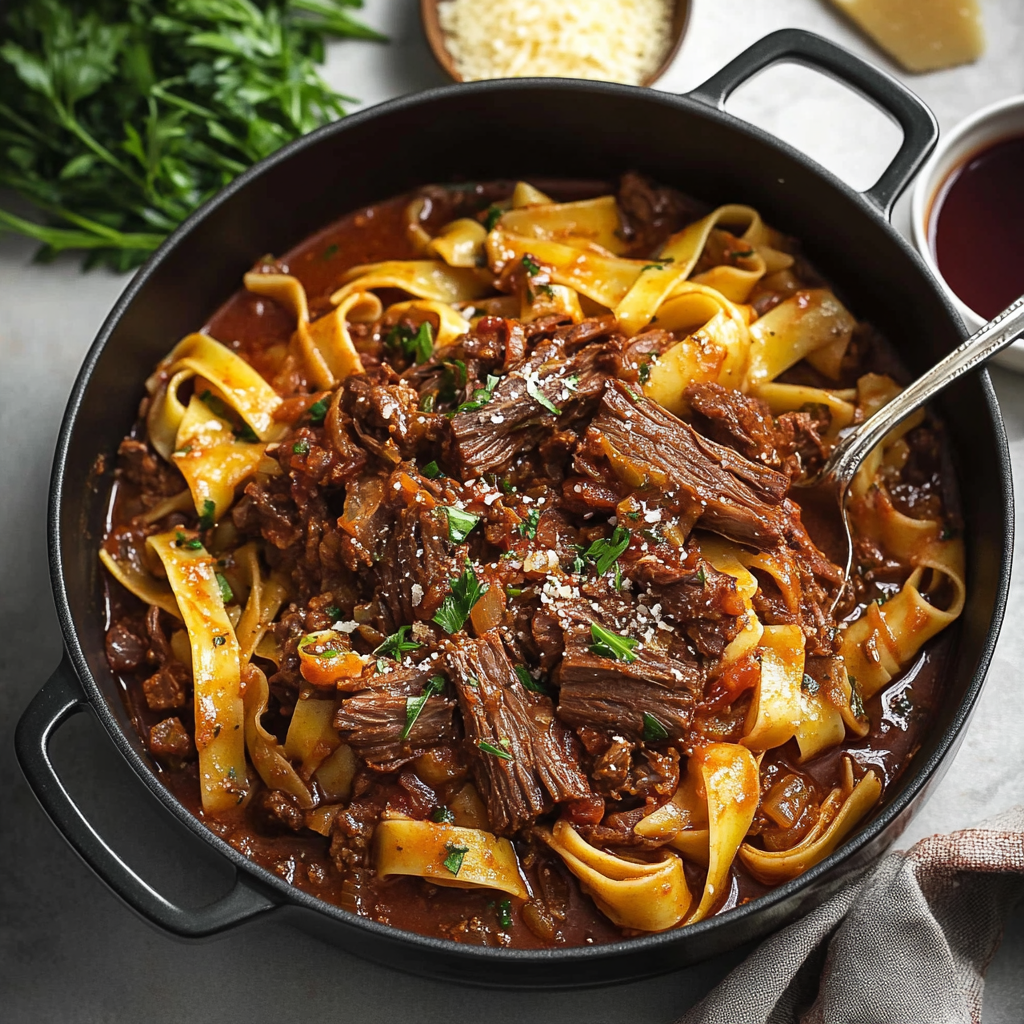This Slow-Braised Short Ribs in Red Wine Sauce is the epitome of comfort food. The tender beef, rich tomato base, and aromatic herbs create a dish that’s both hearty and satisfying. Perfect for a cozy evening, this ragù pairs beautifully with tagliatelle or pappardelle. The slow-cooked flavors meld together, making it a meal worth savoring.
Whether you’re hosting a dinner party or enjoying a quiet night in, this dish promises to impress and delight. Serve it with a glass of red wine and a sprinkle of freshly grated Parmigiano Reggiano for the ultimate dining experience.
Full Recipe
Ingredients:
-
2 lbs beef short ribs, de-boned and cut into 2″ cubes
-
2 tbsp light olive oil (or vegetable/avocado oil)
-
Kosher salt, to taste
-
1 cup white onion, finely diced
-
½ cup celery, finely diced
-
½ cup carrot, finely diced
-
4 garlic cloves, finely minced
-
2 tbsp tomato paste
-
1 cup red wine
-
1 cup beef or chicken broth
-
1¾ cups crushed tomatoes (14 oz can)
-
Herb bundle: rosemary, thyme, parsley stems
-
2 bay leaves
-
2 tbsp sherry or red wine vinegar
-
1 lb pasta (tagliatelle or pappardelle)
-
Chopped parsley and grated Parmigiano Reggiano for garnish
Directions:
-
In a large Dutch oven, heat olive oil over medium-high heat. Season short ribs with kosher salt and sear on all sides until browned. Remove and set aside.
-
In the same pot, add diced onion, celery, carrot, and minced garlic. Sauté until vegetables are softened, about 5 minutes.
-
Stir in tomato paste and cook for 2 minutes until it darkens slightly.
-
Pour in red wine, scraping up any browned bits from the bottom of the pot. Let it reduce by half, about 10 minutes.
-
Add crushed tomatoes, broth, herb bundle, and bay leaves. Return short ribs to the pot. Bring to a boil, then reduce heat to low. Cover and simmer for 2½ to 3 hours, until meat is fork-tender.
-
Remove short ribs, discard bones, and shred meat. Return shredded meat to the sauce. Stir in vinegar and adjust seasoning with salt and pepper.
-
Meanwhile, cook pasta according to package instructions. Drain, reserving 1 cup of pasta water.
-
Add cooked pasta and reserved pasta water to the ragù. Toss to combine, allowing pasta to absorb some sauce.
-
Serve hot, garnished with chopped parsley and grated Parmigiano Reggiano.
Prep Time: 30 minutes
Cooking Time: 3 hours
Total Time: 3 hours 30 minutes
Kcal: 657 kcal per serving
Servings: 6
An Italian Classic Rooted in Tradition
Slow-Braised Short Ribs in Red Wine Sauce, or short rib ragù, is a timeless dish that reflects the heart of Italian cuisine—simple ingredients, elevated through time and technique. At its core, it is a comforting, soul-warming meal that has been passed down through generations, often made on Sundays or during holidays, where families gather around the table to share food, conversation, and love. The use of short ribs as the protein of choice adds a deep, beefy richness that stands up to long, slow cooking.
The Magic of Braising
Braising is the key technique used in this recipe and is a hallmark of rustic Italian cooking. The method involves first searing the short ribs to develop a caramelized crust that enhances the flavor, then slowly simmering them in a mixture of aromatic vegetables, red wine, tomatoes, and herbs. This long cooking process breaks down the tough connective tissue in the meat, transforming it into tender, melt-in-your-mouth bites. The result is a ragù with incredible depth and complexity, both hearty and elegant.
Why Short Ribs?
Short ribs are an ideal cut of meat for braising due to their marbling and connective tissue, which translates into flavor and tenderness when cooked low and slow. Compared to other meats used in ragù, such as ground beef or pork, short ribs elevate the dish into something more luxurious and indulgent. When cooked properly, the meat becomes fork-tender and easily shreds into the sauce, imparting a rich, meaty flavor throughout.
The Role of Red Wine
Red wine plays a vital role in the sauce, lending acidity, body, and a touch of sweetness. It helps deglaze the pan after searing the meat and sautéing the vegetables, pulling up all those flavorful browned bits. As it simmers, the alcohol evaporates, and the wine reduces, leaving behind a robust base that perfectly complements the tomatoes and beef. A dry red wine like Chianti, Barolo, or Cabernet Sauvignon is typically used, adding a rustic elegance to the final dish.
Aromatics and Herbs: Building Flavor Layers
Another layer of depth in this dish comes from the soffritto—the classic Italian trinity of onion, celery, and carrot—which is sautéed until soft and golden. Garlic is also added to boost the flavor. Fresh herbs like rosemary, thyme, parsley, and bay leaves are bundled together and simmered with the sauce, infusing it with an earthy, herbal aroma that permeates every bite. These simple aromatics transform the sauce into a sophisticated ragù worthy of a festive table.
Perfect Pasta Pairings
While the sauce is undoubtedly the star, its supporting cast—pasta—should not be overlooked. Wide, flat noodles like tagliatelle or pappardelle are ideal for short rib ragù because their surface area and ridges cling beautifully to the thick sauce. The texture of these egg-based pastas enhances the mouthfeel and ensures every bite is balanced. It’s also common to see this ragù served over creamy polenta, gnocchi, or even as a filling in baked pasta dishes like lasagna.
The Importance of Patience
This is not a 30-minute weeknight dinner. It’s a meal that requires patience, care, and time—qualities that reflect its rustic Italian roots. But that time investment pays off in full. The slow simmering not only tenderizes the meat but also allows the flavors to deepen and meld. In fact, many cooks argue that this dish tastes even better the next day, making it ideal for preparing in advance for dinner parties or family gatherings.
Make-Ahead and Freezer Friendly
One of the great benefits of this dish is its versatility when it comes to storage. The ragù can be made a day or two in advance and kept in the fridge, where the flavors continue to intensify. It also freezes exceptionally well, making it a great candidate for batch cooking. Simply portion it into freezer-safe containers, and you’ll have a delicious homemade sauce ready to go whenever you need a comforting meal in a pinch.
Entertaining with Elegance
Serving short rib ragù is a surefire way to impress dinner guests. It’s a dish that carries a sense of occasion, even though it’s humble at its core. The rich, hearty sauce ladled generously over pasta, garnished with chopped parsley and shaved Parmigiano Reggiano, becomes a centerpiece on the table. Pair it with a full-bodied Italian red wine and a side of crusty bread for a truly memorable dining experience.
Variations and Regional Twists
While this version leans into the northern Italian tradition, there are countless regional variations of ragù throughout Italy. In Tuscany, wild boar may replace the beef; in Bologna, milk is added to soften the acidity of the tomatoes; in southern regions, spicy Calabrian chilies can give the dish a fiery kick. This adaptability makes the recipe not just timeless, but endlessly customizable to suit local ingredients and personal preferences.
Tips for Best Results
For best results, use bone-in short ribs and remove the bones once the meat is tender. This not only adds extra flavor but helps emulsify the sauce. Deglaze the pot properly to scrape up all the flavorful bits left after browning. Don’t skip the vinegar at the end—it brightens up the dish and balances the richness of the meat and wine. And finally, don’t forget to reserve a bit of pasta water to help bind the sauce to the noodles when you toss them together.
Nutritional Perspective
While short rib ragù is undeniably a rich and indulgent meal, it’s also satisfying and filling, which makes it easier to portion control. The presence of protein from the beef, fiber from the vegetables, and energy from the pasta creates a balanced dish that leaves you feeling nourished. Using high-quality ingredients and avoiding excessive fats ensures it remains a hearty, wholesome meal when enjoyed in moderation.
Cultural Significance
Short rib ragù is more than just a meal; it is a symbol of Italian culinary philosophy—simplicity, seasonality, and family. It embodies the Italian way of life, where meals are not rushed, but savored. Cooking and sharing this dish becomes an experience in itself, reminding us of the importance of slowing down and enjoying the moment. Whether you’re preparing it for your family or sharing it with friends, it’s a recipe that invites connection and warmth.
Conclusion
Slow-Braised Short Ribs in Red Wine Sauce is a dish that transcends time and geography. With its rich, savory depth and comforting aroma, it captures the essence of traditional Italian cooking. Though it takes time to prepare, every moment is rewarded with a sauce so flavorful and a texture so tender, it feels like a warm hug on a plate.
Whether you’re new to making ragù or a seasoned cook, this recipe offers a chance to connect with culinary history, express creativity in the kitchen, and most importantly—bring people together. As with all great dishes, it’s not just about the ingredients or the process; it’s about the memories made around the table. Embrace the slow cooking, enjoy the aroma as it fills your kitchen, and take pride in creating a dish that truly stands the test of time.






